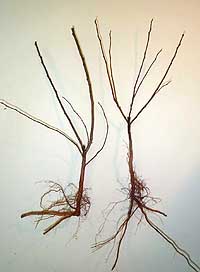
|
Beach Plum Cooperators wanted! At-cost plants available for cooperating growers, researchers. |
| Home page |
 If you've been thinking about starting - or expanding - a beach plum planting, we can provide you with inexpensive plants. In exchange, all that we ask is for your cooperation in letting us collect data from your orchard.
If you've been thinking about starting - or expanding - a beach plum planting, we can provide you with inexpensive plants. In exchange, all that we ask is for your cooperation in letting us collect data from your orchard.The improved cultivars we are developing here at Cornell are still a few years off. In the meantime, we are purchasing bare-root, seed-grown plants from nurseries for distribution to growers and researchers who are willing to work with us. We anticipate that the 10- to 18-inch-tall whips will cost less than 50 cents each. These plants will represent the natural variation in fruit quality and yield you'd expect from seed-grown plants. Delivery will be in early spring 2003. Plan to plant them about 5 feet apart in rows 12 feet apart, or 726 plants per acre. (Find site preparation instructions in the Grower's Guide.) Currently, we are working with about 15 farms in the Northeast with plantings that range in size from 25 to 800 bushes. We are seeking additional growers and other agricultural educators and professionals who want to establish plantings. Our long-term goal is to help beach plum growers form their own self-directed consortium to grow, process and market this native fruit. By placing a bulk order and pooling information on our methods and yields, we will promote the idea of behaving in a cooperative manor. You can choose from two options for participation in this project: Cooperator
|